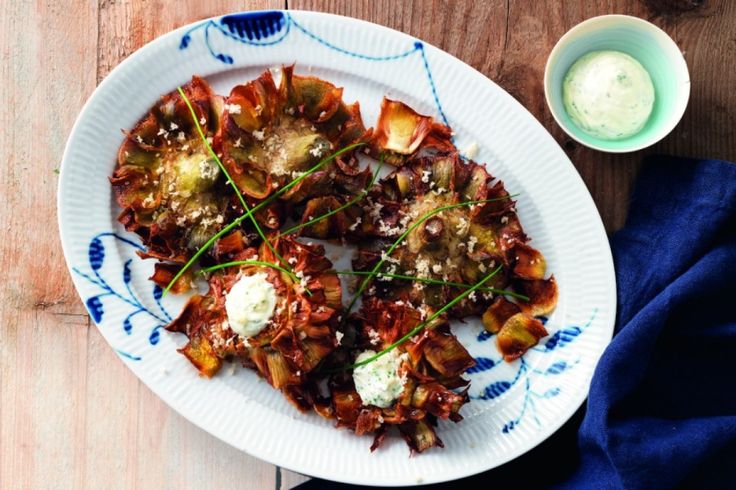1 Delicious Evan Kleiman’s Carciofi Alla Giudia
Craving a taste of Roman tradition? Look no further than Evan Kleiman’s carciofi alla giudia, also known as “Jewish-style artichokes.” This dish is a culinary journey, transforming the humble artichoke into a masterpiece of contrasting textures and flavors.
Our adventure begins with the star ingredient: baby artichokes. Their tender hearts and unopened blooms are the perfect canvas for this culinary transformation.
First, we’ll gently peel away the tough outer leaves, revealing the delicate pale green ones underneath. Trimming the stem and snipping off the top completes the initial shaping.
To prevent browning while we prepare the other elements, Kleiman suggests a simple yet effective trick: an acidulated water bath. Lemon halves and juice create this slightly acidic environment, keeping the artichokes looking vibrant.
Next comes the blanching process. A pot of salted water awaits, ready to give the artichokes a quick but crucial dip. This ensures tender hearts while keeping the leaves pliable, perfect for the next step.
Here’s where the magic truly happens. With gentle hands, we’ll coax the artichoke leaves open, spreading them outward. Imagine transforming a closed bud into a beautiful artichoke flower. This not only exposes more surface area for frying, but also creates the stunning visual presentation that defines this dish.
The stage is set for the grand finale. A deep pot of oil, heated to the perfect temperature, welcomes the artichokes. Carefully submerged, their fanned-out leaves showcase their potential for crispness.
The hot oil works its magic. A gentle sizzle fills the air as the artichoke leaves transform, taking on a beautiful golden-brown hue. The key here is achieving a perfect balance: crisp exteriors that give way to the tender heart within.
Once perfectly golden and crisp, the artichokes are retrieved from the oil. A simple yet essential final flourish awaits: a squeeze of fresh lemon juice. The bright acidity cuts through the richness of the fried artichoke, adding a refreshing touch that elevates the entire dish.
Evan Kleiman’s carciofi alla giudia is a symphony of textures and flavors. Each bite offers a delightful contrast: the crisp, golden shell gives way to the soft, tender heart. The subtle sweetness of the artichoke is perfectly complemented by the tang of lemon, with a hint of saltiness tying everything together.
Carciofi alla giudia is more than just a delicious dish; it’s a window into Roman culinary tradition. The name itself hints at a rich history. Some believe it originated in the Jewish ghetto of Rome, where artichokes were a readily available and affordable ingredient.
Regardless of its exact origin, carciofi alla giudia has become a beloved symbol of Roman cuisine. It graces tables in restaurants, street vendors, and homes alike, a testament to its enduring popularity and versatility.
Bring Rome to Your Kitchen: The Joy of Cooking Carciofi alla Giudia
Evan Kleiman’s recipe makes this Roman treasure accessible to home cooks everywhere. With a little care and attention to detail, you can recreate the magic of carciofi alla giudia in your own kitchen.
So, gather your baby artichokes, fire up your stove, and embark on a culinary adventure. The reward? A plate of golden-fried artichokes, a symphony of textures and flavors, waiting to tantalize your taste buds.

1 Delicious Evan Kleiman’s Carciofi Alla Giudia
Description
1 Delicious Evan Kleiman’s Carciofi Alla Giudia
Craving a taste of Roman tradition? Look no further than Evan Kleiman's carciofi alla giudia, also known as "Jewish-style artichokes." This dish is a culinary journey, transforming the humble artichoke into a masterpiece of contrasting textures and flavors.
Our adventure begins with the star ingredient: baby artichokes. Their tender hearts and unopened blooms are the perfect canvas for this culinary transformation.
First, we'll gently peel away the tough outer leaves, revealing the delicate pale green ones underneath. Trimming the stem and snipping off the top completes the initial shaping.
To prevent browning while we prepare the other elements, Kleiman suggests a simple yet effective trick: an acidulated water bath. Lemon halves and juice create this slightly acidic environment, keeping the artichokes looking vibrant.
Next comes the blanching process. A pot of salted water awaits, ready to give the artichokes a quick but crucial dip. This ensures tender hearts while keeping the leaves pliable, perfect for the next step.
Here's where the magic truly happens. With gentle hands, we'll coax the artichoke leaves open, spreading them outward. Imagine transforming a closed bud into a beautiful artichoke flower. This not only exposes more surface area for frying, but also creates the stunning visual presentation that defines this dish.
The stage is set for the grand finale. A deep pot of oil, heated to the perfect temperature, welcomes the artichokes. Carefully submerged, their fanned-out leaves showcase their potential for crispness.
The hot oil works its magic. A gentle sizzle fills the air as the artichoke leaves transform, taking on a beautiful golden-brown hue. The key here is achieving a perfect balance: crisp exteriors that give way to the tender heart within.
Once perfectly golden and crisp, the artichokes are retrieved from the oil. A simple yet essential final flourish awaits: a squeeze of fresh lemon juice. The bright acidity cuts through the richness of the fried artichoke, adding a refreshing touch that elevates the entire dish.
Evan Kleiman's carciofi alla giudia is a symphony of textures and flavors. Each bite offers a delightful contrast: the crisp, golden shell gives way to the soft, tender heart. The subtle sweetness of the artichoke is perfectly complemented by the tang of lemon, with a hint of saltiness tying everything together.
Carciofi alla giudia is more than just a delicious dish; it's a window into Roman culinary tradition. The name itself hints at a rich history. Some believe it originated in the Jewish ghetto of Rome, where artichokes were a readily available and affordable ingredient.
Regardless of its exact origin, carciofi alla giudia has become a beloved symbol of Roman cuisine. It graces tables in restaurants, street vendors, and homes alike, a testament to its enduring popularity and versatility.
Bring Rome to Your Kitchen: The Joy of Cooking Carciofi alla Giudia
Evan Kleiman's recipe makes this Roman treasure accessible to home cooks everywhere. With a little care and attention to detail, you can recreate the magic of carciofi alla giudia in your own kitchen.
So, gather your baby artichokes, fire up your stove, and embark on a culinary adventure. The reward? A plate of golden-fried artichokes, a symphony of textures and flavors, waiting to tantalize your taste buds.
Ingredients
Instructions
-
To prevent browning, prepare an acidic environment.
-
In a bowl, combine water with the juice of a squeezed lemon.
-
Toss in the spent lemon halves as well. Set this aside for now.
-
Now, let's get our artichokes ready for their starring role.
-
One by one, gently peel away the tough, dark green outer leaves until you reveal the more tender, yellowish ones underneath.
-
Imagine peeling back the layers of an onion.
-
Using a sharp knife, carefully cut off the pointed tip of the artichoke.
-
Next, trim the stem.
-
Remove the dark green outer layer, exposing as much of the heart as possible.
-
Remember, the heart is the prized treasure within the artichoke.
-
As you work your way through the artichokes, place each trimmed one into the prepared lemon water bath.
-
This acidic environment will keep them looking vibrant until they're ready for the next step.
-
Fill a saucepan with water and bring it to a boil. Don't forget to add a generous amount of salt for extra flavor.
-
Once the water is boiling, carefully add the trimmed artichokes.
-
Give them a one-minute bath, or until the leaves become pliable.
-
If your artichokes are on the larger side, use a paring knife to check for tenderness in the heart.
-
A gentle pierce should slide in easily.
-
Using a slotted spoon, gently lift the artichokes out of the boiling water and transfer them to a bowl of ice water.
-
This quick chill stops the cooking process, locking in their vibrant green color and tender texture.
-
Now comes the signature touch! With gentle hands, carefully pry open the leaves of each blanched artichoke.
-
Imagine transforming a closed bud into a beautiful flower.
-
To encourage the leaves to stay open, tap them gently, leaf side down, on a countertop.
-
Once open, place the artichokes upside down on paper towels to drain any excess moisture. They can be stored this way for up to two days, so don't worry if they discolor a bit; it won't affect the flavor and will disappear once fried.
-
Fill a saucepan or wok with olive oil, aiming for a depth of 1 1/2 to 2 inches.
-
Heat the oil over medium-high heat.
-
Once the oil is hot, carefully add the artichokes one at a time, stem side up.
-
Use tongs to gently hold them submerged in the oil for a brief moment.
-
This helps set the leaves in their open, flower-like shape.
-
Carefully turn the artichokes over and continue frying until the heart becomes tender when pierced with a paring knife.
-
As each artichoke reaches golden perfection, remove it from the oil and let it drain on paper towels to absorb any excess grease.
-
Sprinkle the fried artichokes with a touch of salt to enhance their flavor.
-
Serve them warm on a platter, accompanied by wedges of fresh lemon for squeezing.


